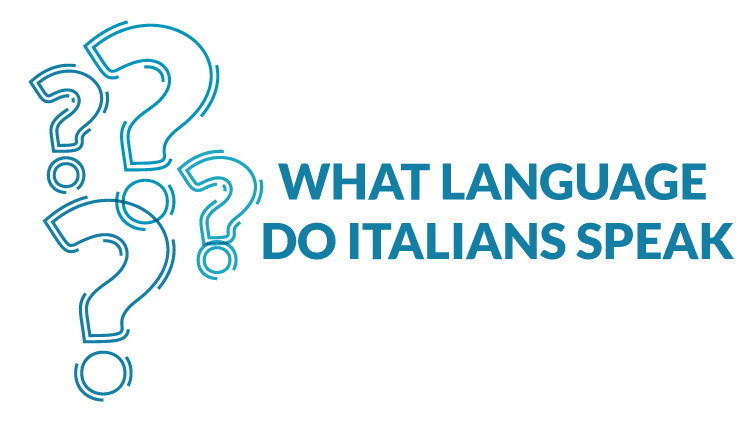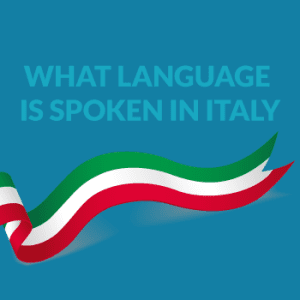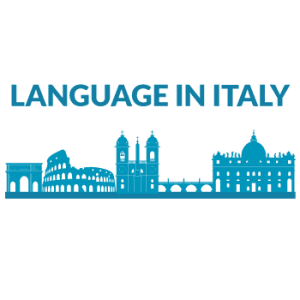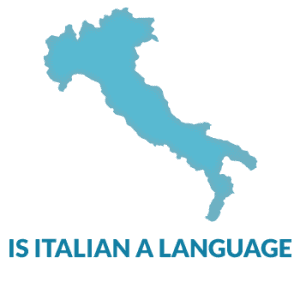What Language Do Italians Speak?

If you’re traveling to Italy, you’ll want to know what language Italians speak! Though Italian is the official language of Italy, there are many dialects spoken around the country. While they can be mutually intelligible with each other, they also have some differences in pronunciation, vocabulary, and grammar. This article will teach you about the languages spoken in Italy so you can communicate easily with native speakers when you visit!
The national language of Italy
One question that always comes up when discussing what language is spoken in Italy regards whether or not Italian is even its language. Is Italian a language? Italian is, by law, both the official language of Italy and an official minority language in regions where it is prevalent.
The Italian language is derived from Latin (from which the English language also descends) and has a lot in common with French, Spanish, Portuguese and Romanian. It is written using a modified Latin alphabet.
The most commonly spoken regional languages are Lombard (spoken in Northern Italy), Ladin (spoken in South Tyrol), Piedmontese (in northwest Piedmont), Sicilian poets (the original vocabulary of Sicily), and Sardinian, which predates Latin by several centuries and has many unique features retained even today. However, as you travel throughout Italy, you will find plenty of dialects and variations in these main languages.
For example, in Tuscany, you may hear people speaking Tuscan or Florentine instead of standard Italian. In Naples and surrounding areas, you might listen to Neapolitan instead of traditional Italian.
Regional Dialects and Languages in Italy
In Rome, the Roman dialect can be heard instead of standard Italian. And so on. As you can see, each region has its distinct way of speaking, and while they are all very similar to one another, they do have their specific differences.
As for what language is spoken in Italy – well, if we look at it geographically, then we could say that different languages are spoken in other parts of Italy! But let’s break down what languages are being used across Italy.

Because some parts of northern Italy were historically under French rule, some words have been borrowed from French into Italian. Italian is a very musical language with different intonations and accents, which can convey different meanings depending on how they are spoken. The most common dialects in Italy are Tuscan (Florentine), Roman, Neapolitan, Sicilian, and Sardinian.
The first three are considered part of standard Italian, but Sicilian and Sardinian have many unique features that make them quite distinct. For example, while both Sicilian and Sardinian belong to modern romance languages (just like French or Spanish), they share more similarities with other non-romance languages such as Greek or Albanian!
Minority Languages
There are over sixty minority languages spoken in Italy. The minority languages of Italy are an essential part of the country’s cultural heritage. However, many of these languages are endangered. Efforts are being made to protect and promote minority languages, but more must be done to ensure their survival.
Sardinian is the most endangered minority language of Italy. It is spoken by only about 1.4% of the population, and most of those speakers are over the age of 60. The Sardinian language is at risk of extinction because it is not passed down to younger generations.
There are several reasons for this, including Sardinian is not used in the education system or the media. Additionally, many young people leave Sardinia in search of work, which further contributes to the decline of the Sardinian language.
Endangered Minority Languages in Italy
Occitan is another endangered minority language of Italy. It is spoken by about 0.4% of the population, most of whom live in the northwestern region of the country. Occitan is a modern romance language closely related to French and Catalan.
Like Sardinian, Occitan is not used in the education system or the media, contributing to its decline. Additionally, the Occitan-speaking region of Italy is economically disadvantaged, making it difficult for the native language to compete with Italian.
Franco-Provençal is a minority language of Italy that is spoken by about 0.2% of the population. Most Franco-Provençal speakers live in the northwestern region of the country, where they are outnumbered by Occitan speakers. Franco-Provençal is a Romance language that is closely related to French.
Like Sardinian and Occitan, Franco-Provençal is not used in the education system or in the media, which has contributed to its decline. Additionally, the Franco-Provençal-speaking region of Italy is economically disadvantaged, making it difficult for the language to compete with Italian.

Italian Dialects
The Italian language, the national language, is a Romance language spoken by around 70 million people across Italy, Switzerland, San Marino, and Vatican City.
The official languages of Italy are Italian, and recognized minority languages include German, French, Slovene, and Albanian. While Italian is an official language in many countries around Europe and has some native speakers in South America, people commonly speak one of the thousands of dialects based on local variations but still use standard grammar.
Dialects can be so different that they may be incomprehensible to other Italians. In northern regions such as Lombardy, Emilia-Romagna, and Piedmont, Franco-Provençal dialects were historically spoken before being replaced with different variants of Italian. In these areas, there are also regional languages, including Ladin (in Valle d’Aosta), Friulan (in Friuli), and Venetian (in Veneto).
These regional languages have been greatly influenced by Latin and Italian over time but remain distinct from standard Italian. Due to heavy immigration from Eastern Europe over recent decades, many people in Italy now speak Slavic languages at home, including Romanian, Ukrainian, and Croatian.
The most commonly spoken languages in Italy
The most commonly spoken language in Italy is Italian, of course, and Sardinian. For example, Tuscany is one of Italy’s most famous regions for its wine and hospitality, but it’s also home to several minority languages, including Sardinian.
On the rest of the island, around one million people, or 1.7 percent of the Italian population, speak Sardinian. With a long history that dates back over four millennia, Sardinian is considered one of Europe’s oldest languages. Although it’s not an official language in Italy today, around 1-2% of Italian citizens speak it natively.
The language may be endangered by today’s standards, but that doesn’t mean you can’t make an effort to learn more about it—Sardinia is one of Italy’s top vacation destinations, thanks to its beautiful scenery, stunning beaches, and world-class cuisine. Foodies will be delighted to know that several dishes in Sicily and Sardinia are only served at certain times of the year due to ingredients’ availability or cultural traditions.
A Brief History Of The Italian Language
The Italian language has a long and complex history, dating back to the ancient Romans. Today, it is spoken by over 60 million people around the world. Italian is a Romance language, which means it is derived from Latin. However, it has also been influenced by other languages over the centuries, including German, French, and Arabic.
In the 13th century, the evolution of the literary language became a cornerstone of European cultural heritage. During this period, various European languages underwent transformations, giving rise to distinctive literary forms that would shape the region’s linguistic landscape for centuries to come.
The literary language of the 13th century not only served as a means of expression but also became a repository of cultural values, historical narratives, and artistic achievements. It played a pivotal role in fostering a sense of identity and shared heritage among diverse communities across Europe.
The literary productions of this era continue to be revered today for their linguistic richness and the cultural insights they offer into the tapestry of European history. The Italian language has three main periods: Old Italian (up to the 14th century), Middle Italian (14th-16th century), and Modern Italian.
Linguistic Diversity in Southern Italy
In Southern Italy, a region characterized by a rich tapestry of historical and cultural diversity, the coexistence of various foreign languages has played a significant role over the centuries. Italian speakers encountered not only a separate language landscape but also a plethora of distinct dialects and languages.
Throughout the 18th, 19th, and 20th centuries, Southern Italy was home to numerous historical language minorities, each contributing to the linguistic mosaic of the region. As a result, official documents often reflected this linguistic diversity, with the standard language evolving against the backdrop of these various influences.
Southern Italy’s common language evolved through the interaction of regional dialects and foreign languages, reflecting the area’s complex linguistic history. John Charles significantly impacted linguistics, founding John Benjamins Publishing Company, which shaped scholarship on linguistic diversity and late 19th-century culture.
John Charles explores the nuanced use of articles in language and acknowledges the cultural significance of non-national languages in soft power.
The term “minoranze linguistiche” encapsulates his exploration of linguistic minorities, shedding light on the intricate interplay between language, identity, and societal structures. Through his scholarly pursuits, John Charles continues to illuminate the complexities inherent in language and its role in shaping our understanding of diverse cultural landscapes.


Old Italian
The Old Italian period covers the time up to the 14th century. This was when the Roman Empire was at its height, and Latin was the dominant language. However, there was a lot of regional variation in how Latin was spoken, and Italian developed as a distinct dialect in the region of Tuscany. Old Italian was also influenced by other languages, including German, French, and Arabic.
Old Italian has a long and rich history. It was the first language of the Roman Empire, and it has been spoken in Italy for over two thousand years. Old Italian has also been influenced by several other languages, including Latin, Greek, Arabic, and French. As a result, it is an exciting and complex language.
Old Italian is also an excellent language. It is known for its lyrical quality, and its speakers often use flowery and poetic language. Old Italian is also known for its musicality, and it is often used in opera and other forms of classical music. Old Italian is closely related to several languages, including French, Spanish, and Portuguese. This means that learning Old Italian can help you understand these other languages better. There are several free websites people do use for Italian translation.
Middle Italian
Middle Italian is a period in the history of the Italian language that lasted from the 13th to the 16th century. It was a time of significant change for the language, as it underwent a major transformation from its earlier form, known as Old Italian. This essay will explore three aspects of Middle Italian: its history, its major features, and its influence on modern Italian.
Middle Italian began to develop in the 13th century, as the Old Italian dialects began to diverge from one another. This process was accelerated by the political fragmentation of the country, which led to the rise of regional dialects. By the 14th century, Middle Italian was the dominant form of the language, and it continued to evolve over the next two centuries.
Middle Italian is characterized by several features, including the development of a standard literary language, the influence of other languages such as French and Spanish, and the use of loanwords. The standard academic language was based on the Florentine dialect, which became the model for other writers in Italy. The influence of other languages can be seen in the increased use of loanwords, mainly French and Spanish.
The impact of Middle Italian can still be seen in the modern Italian language. Many of the features that developed during this period, such as the standardization of the language, the influence of other languages, and the use of loanwords, are still present in Italian today.
Morden Italian
The Modern Italian period began in the 16th century. This was a time of outstanding cultural achievement in Italy, with the Renaissance and the rise of the Baroque. Modern Italian is characterized by a more uniform grammar and greater use of standard Italian words. Modern Italian is a fascinating language that has its roots in Latin. It is spoken by over 60 million people worldwide and is the official language of Italy. Modern Italian has undergone many changes over the centuries but is still considered to be one of the most beautiful languages in the world.
Another exciting aspect of Modern Italian is its regional dialects. While there is a standard form of the language, there are also many regional dialects that are spoken throughout Italy. These dialects can often be very different, and they add a lot of color and variety to the language. Modern Italian is also a very musical language. Italian is known for its beautiful melodies and poetic lyrics, and this is reflected in the language itself. Many Italian words have a very lyrical quality and are often used in songs and poems.
Gallo-Italian Languages
The Gallo-Italian languages are a group of closely related Romance languages spoken in northern Italy. They include some of the most widely spoken languages in Italy, such as Piedmontese, Lombard, and Emilian-Romagnol. There are three main groups of Gallo-Italian languages: Western, Central, and Eastern. Western Gallo-Italian languages are spoken in the northwestern part of Italy, including Piedmont, Liguria, and Aosta Valley.
Central Gallo-Italian languages are spoken in the north-central part of the country, including Lombardy, Emilia-Romagna, and the Trentino-Alto Adige/Südtirol region. Eastern Gallo-Italian languages are spoken in the northeastern part of Italy, including Veneto and Friuli-Venezia Giulia. The Gallo-Italian languages share many features with other Romance languages, but they also have some unique characteristics.
For example, they are characterized by a strong influence from the Gallo-Romance languages, as well as several loanwords from Germanic languages. Gallo-Italian languages are spoken by about 15 million people in Italy. They are an essential part of the country’s linguistic heritage and have played a significant role in its culture and history.
How Many People In The U.S. Speak Italian?
According to a recent study, there are approximately 3 million people in the United States who speak Italian. This number represents about 1% of the population. While this may seem like a small number, it is pretty significant. Italian is the fourth most spoken language in the country, behind English, Spanish, and Chinese.
There are several reasons why so many people in the United States speak Italian. First, Italy has a long and rich history. For centuries, Italy has been a major cultural and artistic center. This has made Italian a popular language to learn among people interested in art and culture. Second, Italy is a major tourist destination.
Every year, millions of people visit Italy to see its beautiful cities and stunning scenery. This has made Italian a popular language for people who travel frequently. Finally, Italy is a significant economic power. Many businesses in the United States have ties to Italy, and this has made Italian a popular language for people who work in the business world.
One of the reasons why so many people in the United States speak Italian is because Italy has a long and rich history. For centuries, Italy has been a major cultural and artistic center. This has made Italian a popular language to learn among people interested in art and culture.
Italy, known for artists like da Vinci and Michelangelo, boasts iconic landmarks and a rich history, making it a sought-after language to learn. Italy hosts major companies like Fiat and Eni, and its wine and fashion industries make Italian a valuable language in business.
Some facts about the Italian language
There are several languages spoken in Italy, with Italian being one of them. Italian is a Romance language and the official language of Italy, Switzerland, San Marino, and Vatican City. The Italian alphabet has 21 letters; vowels are 14, while consonants are 7.
It belongs to the Indo-European family, the Italic group of Romance languages. Other regional languages that belong to the same family include Romanian, Spanish, French, Catalan, and Portuguese, among others.
Stressed vowels, especially the close-mid vowel, characterize Friuli Venezia Giulia’s linguistic landscape, which is rich in regional languages and dialects.
Linguistic Diversity in Italy
The coexistence of these linguistic elements underscores the European language diversity present in Friuli Venezia Giulia. The intricate interplay of regional languages challenges the notion of a separate language, highlighting the nuanced ways in which linguistic identities are shaped in this culturally vibrant region.
The two most spoken variants within Italy are Standard Italian and Sicilian. Standard Italian is also known as the Tuscan dialect, whereas Sicilian is spoken in Sicily. Despite its name, it’s not an official language in Italy but is instead recognized minority language by law nr 482/1999. Apart from these two, other dialects include Neapolitan (spoken around Naples), Milanese (spoken around Milan), Piedmontese (spoken around Turin), etc.
Another interesting fact about the Italian language is that it’s derived from Latin, which was later influenced by Greek, Germanic tribes, and Slavic peoples such as Slovenians. Many people think that Italian is a variation of Latin.
Although there are no exact figures available on how many people speak Italian worldwide, it’s estimated to be around 60 million speakers in Europe alone. If you plan on visiting Italy soon or have been planning for years now, brush up your knowledge of Italian beforehand so you can communicate better with locals!
Tuscan Dialect’s Impact on Modern Italian
The Tuscan dialect significantly shaped modern Italian, influencing its null-subject status and reflecting the identity of Italy’s language minorities.
These dialects thrived in isolation, especially in remote areas like the Alpine valleys, well into the late 19th century. JLinguist John Charles highlighted the unique linguistic elements preserved in native dialects, which significantly differ from standard Italian. The diverse dialects of Italy reveal its cultural richness and provide valuable insights into the historical evolution of the Italian language.
The Tuscan dialect significantly influenced modern Italian’s development as a null-subject language, integral to Italy’s historical language minorities’ identity.
These dialects thrived in isolation, especially in remote areas like the Alpine valleys, well into the late 19th century. John Charles highlighted how native dialects preserve unique elements, showcasing Italy’s cultural diversity and offering insights into Italian language development.
Evolution in 18th Century Italy
In the 18th century, Central and Southern Italy’s dialects featured stressed vowels, a close-mid vowel distinction, and allowed omitting subjects when context provided clarity.
This feature aligns with several other Romance languages. These dialects have complex rules for assigning gender to nouns, which often follow grammatical conventions rather than biological gender.
These traits enrich Italy’s linguistic minorities, showcasing a historical tapestry of language evolution shaped by regional and social dynamics.
During the 19th century, the linguistic characteristics of Italian speakers, particularly those in Central and Southern Italy, were richly defined by their usage of stressed vowels and a close-mid vowel system. These phonetic nuances contributed significantly to the dialectal diversity within the Italian language.
The prevalence of stressed vowels in these dialects often affected the pronunciation and intonation patterns, distinguishing them from other regional languages of Italy.
Linguistic Features of Standard Italian
The role of indefinite articles in these dialects showcased their grammatical intricacies, adapting to the phonetic environment set by the vowel sounds. Scholarly publications emphasize how 19th-century Italian linguistic elements reveal its phonological landscape and broader socio-linguistic dynamics.
Standard Italian has evolved from regional dialects, featuring distinct linguistic characteristics that set it apart from other Romance languages. One such feature is its status as a null-subject language, which allows the omission of the subject in sentences where it is implied by the verb.
Scholarly publications discuss Standard Italian’s complex grammatical features, including gender-based indefinite articles, reflecting the language’s depth and historical richness.
Frequently Asked Questions
No, Italian and French aren’t the same. Both Romance languages from Latin, they belong to different subfamilies with notable differences.
Italian and Spanish, both Romance languages, share similarities but differ in complexity, with Italian being grammatically complex and Spanish more concise.
The Foreign Service Institute considers Italian one of the easiest languages for English speakers, requiring fewer hours to achieve fluency than Russian.
Learning Italian enriches your appreciation of art, literature, and music, and enhances understanding of related Romance languages like French and Spanish.
Finding free Italian learning resources can be challenging, but YouTube, Reddit, and Facebook groups offer helpful options for learners.




